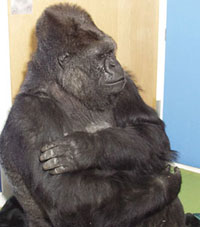Mother’s Day always accentuates the fact that Koko’s greatest wish is to have a baby of her own. We’ve known this for years, as she often signs the word BABY (see photo at left) and carries her gorilla dolls the way gorilla mothers carry their babies. She even pretends that her baby dolls can sign by molding their arms and hands in play or in response to questions.. Koko also treats her kittens as if they were surrogate babies. For example, in the video clip: “***Koko and Moe” you can see Koko wrapping a visiting kitten (Moe) in a pink blanket, and holding Moe while repeatedly making the sign BABY, with increasing emphasis. People often ask why Koko has never had a baby, what it would take for her to have a baby now, and how much time she has to make it happen. Let me try to answer all three of these questions here.
- Koko has lived with two male gorillas most of her life, Michael (who passed away in 2000) and Ndume. Michael and Koko grew up together and developed a sibling relationship. Ndume came to live with Koko when they were both teenagers (she selected him from a video), and hence was considered a much more likely mate. Although Koko and Ndume do get along very well and spend lots of time together, Koko has still not initiated mating. We attribute this to two major factors: a) the natural ratio of females to males in a gorilla family structure is not one to one, but usually three or more females to one male, and b) more privacy and natural habitat are needed— the facility in Northern California is just not private or warm enough to provide the ideal conditions for raising a family.
- Koko and Ndume’s move to Maui (anticipated in 2003 if we meet our fundraising goals) will solve the privacy and natural habitat problem, and increase the chances of acquiring female companions, as the Maui Ape Preserve will be an ideal place for other gorillas needing a home.
- Koko will be 31 on July 4, 2002. Female gorillas in captivity can live into their fifties, and have babies into their early forties but, as with humans, there are increased risks associated with postponed childbearing. Adoption of a gorilla baby is another possibility. And yes, we have tried artificial insemination, but this technique is rarely sucessful with gorillas. In-vitro fertilization has had some limited success with gorillas, but it is dangerous because of the multiple anesthesias required. Natural conception seems to be the most desirable solution for Koko.
I hope that by next Mother’s Day we will be much closer to establishing the proper conditions for Koko to become a mother and pass on sign language to her offspring. The sooner we can make this happen, the more time Koko will have to enjoy her family. . . . Penny


